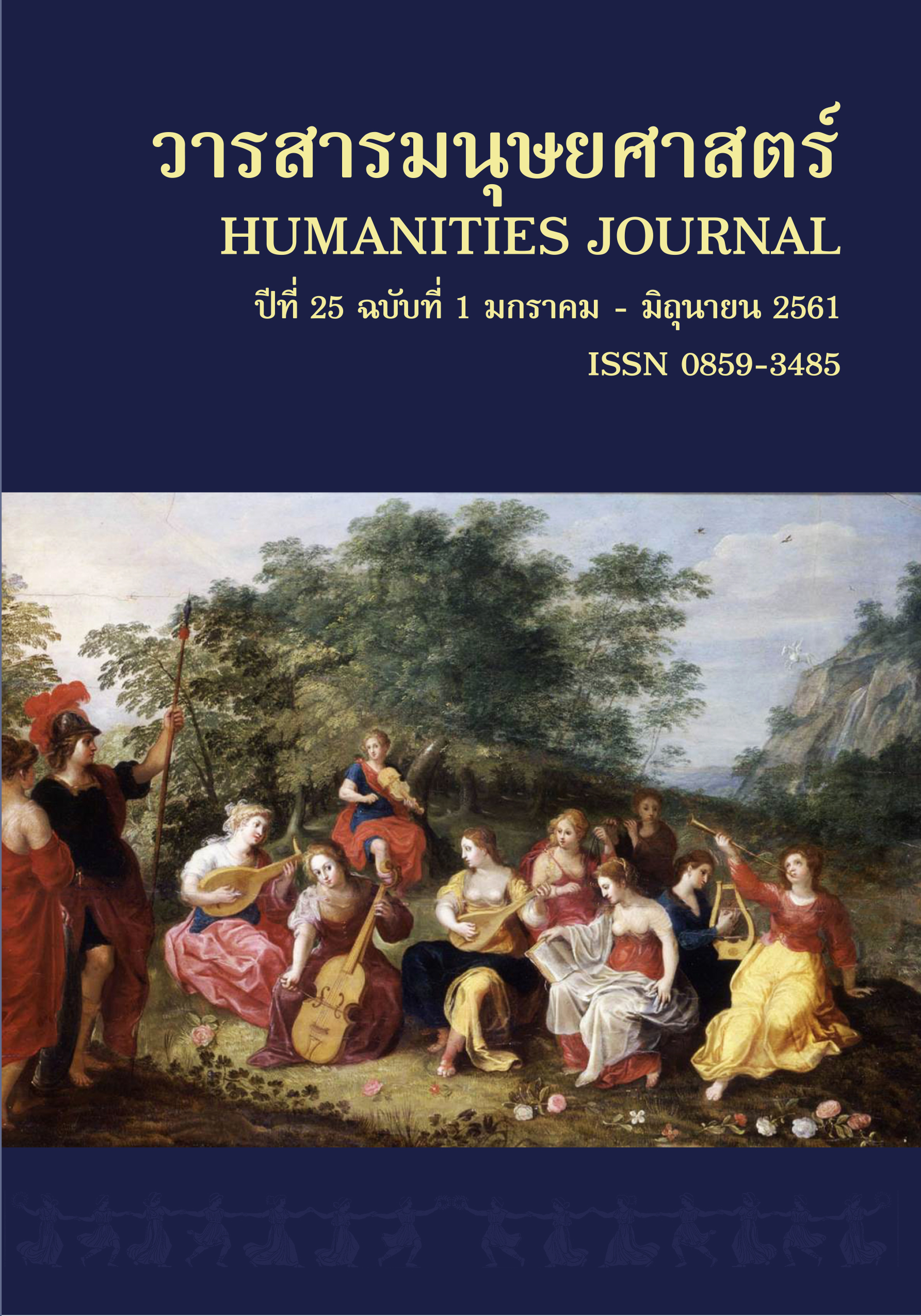วงเครื่องสายผสมกับปรากฏการณ์การเปลี่ยนผ่านงานดนตรีในสยาม -
Main Article Content
Abstract
เครื่องสายผสมกับปรากฏการณ์การเปลี่ยนผ่านงานดนตรีในสยาม
ณัฐชยา นัจจนาวากุล *
บทคัดย่อ
บทความนี้ มีวัตถุประสงค์ เพื่อนำเสนอปรากฏการณ์การเปลี่ยนผ่านงานดนตรีไทยในสยามผ่านวงเครื่องสายผสม ซึ่งเป็นวงดนตรีไทยร่วมสมัยประเภทหนึ่ง เกิดขึ้นในช่วงปลายรัชกาลที่ 5 และมีบทบาทอย่างยิ่งต่อผู้คนในช่วงรัชกาลที่ 6 เป็นต้นมา วงเครื่องสายผสมเป็นวงดนตรีไทยที่แสดงให้เห็นถึงการก้าวข้ามมโนทัศน์วงเครื่องสายในอดีต แสดงให้เห็นถึงการปรับตัวระหว่างดนตรีไทยและดนตรีนอกวัฒนธรรมไทย สะท้อนความเป็นดนตรีร่วมสมัย ทั้งในด้านแนวคิด หลักการบรรเลง การผสมวง ที่มีความแตกต่าง ท้าทายแบบแผนการบรรเลงดนตรีไทยที่เคยมีมาในอดีต ดังนั้นพัฒนาการของวงดนตรีไทยที่เกิดขึ้นในช่วงระยะเวลาต่างๆ จึงเป็นสิ่งสะท้อนให้เห็นถึงการรับ การแลกเปลี่ยน รวมทั้งค่านิยมและกระแสวัฒนธรรมจากภายนอกที่เข้ามาเป็นกำลังในการขับเคลื่อนพลังในการสร้างสรรค์และการประยุกต์วัฒนธรรมดั้งเดิมให้ดำเนินต่อไปได้ภายใต้การปรับตัวของกระแสโลกตะวันตกในเวลานั้น ในขณะที่วงเครื่องสายผสมประเภทต่างๆ ซึ่งก่อกำเนิดขึ้นตั้งแต่ครั้งรัชกาลที่ 5 เป็นต้นมา กลับเป็นตัวแทนแนวคิดของดนตรีที่เน้นการแสดงออกในเรื่องความไพเราะ ความกลมกลืนของท่วงทำนองและการใช้เสียงของเครื่องดนตรีต่างชาติที่ให้คุณลักษณะเสียงแปลกใหม่ เลือกใช้เสียงประสาน ดำเนินทำนองอย่างคู่ 8 นิยมเลือกบทเพลงประเภทบังคับทางมาใช้ในการบรรเลงเพื่อแสดงถึงความไพเราะ ขณะเดียวกันก็ใช้เพลงประเภทดำเนินทำนองในการบรรเลงเพื่อแสดงถึงทักษะในการดำเนินทำนองรูปแบบต่างๆ รวมทั้งการบรรเลงเพลงเดี่ยวเพื่ออวดฝีมือด้วย
วงเครื่องสายผสมยังแสดงให้เห็นถึง การเปลี่ยนผ่านรูปแบบการเรียนการสอนดนตรีไทย ซึ่งจากเดิมนั้นอาศัยการเรียนรู้จากสำนักดนตรีหรือบ้านเป็นหลัก ด้วยวัฒนธรรมการถ่ายทอดองค์ความรู้แบบปากต่อปาก ตัวต่อตัว ส่งผลให้รูปแบบการถ่ายทอดดนตรีไทยทุกประเภท อยู่ภายใต้โครงสร้างกระบวนการเรียนรู้ทีเป็นแบบแผน ปรากฏเป็นขนบสืบทอดเรื่อยมา การเปลี่ยนแปลงกระบวนการดังกล่าว เกิดขึ้นภายหลังยุคปฏิวัติอุตสาหกรรมได้เข้ามามีบทบาทต่อวิถีชีวิตนักดนตรีชาวสยามในเวลานั้น ขณะเดียวกันการใช้เวลาว่างอย่างตะวันตกก่อให้เกิดรูปแบบวิถีชีวิตใหม่ๆ เกิดการเรียนรู้และความนิยมแพร่กระจายออกไปเป็นวงกว้าง ไม่ได้จำกัดเพียงพื้นที่เมืองหลวงแต่เพียงอย่างเดียว นอกจากนี้พัฒนาการด้านการพิมพ์ ยังก่อให้เกิดการสื่อสารองค์ความรู้จากเดิมที่ใช้การถ่ายทอดด้วย การต่อเพลงโดยตรงจากครูสู่ศิษย์ ก็กลับกลายเกิดการสื่อสาร เรียนรู้ผ่านสื่อระบบโน้ตตัวเลข โน้ตซอลฟา แบบฝึกด้วยตนเอง และแผ่นเสียง ส่งผลให้ผู้เรียนบางกลุ่มไม่ต้องพึ่งพาสำนักดนตรีอย่างเคร่งครัด เป็นการถ่ายทอดดนตรีไทยรูปแบบใหม่ ที่ข้ามผ่านวัฒนธรรมการถ่ายทอดดนตรีไทยซึ่งอาศัยครูเป็นสำคัญ
-------------------------------
* อาจารย์ประจำวิทยาลัยดุริยางคศิลป์ มหาวิทยาลัยมหิดล
Thai String Ensemble with an Addition and the Phenomena of Thai Classical Music Transitions in Siam
Nachaya Natchanawakul*
Abstract
This article aims to present the phenomena of Thai classical music transitions in Siam through the string ensemble, a type of contemporary Thai classical music band originated towards the end of the reign of King Rama V and has played a significant role from the period of King Rama VI onwards. Thai string ensemble with an addition represents the conceptual transcendence from the string band of the past, shows the adjustment between Thai and non-Thai music, reflects the ideas of contemporary music in its concept as well as performance and ensemble principles that differ and challenge the formulae of Thai classical music performance in the old days. Therefore, the development of Thai classical music bands in different periods reflects the adoption, exchange and values of external cultural currents that have driven the creative energy and stimulated the application of traditional culture to adjust to western influences. The different types of Thai string ensemble with an addition originated since the time of King Rama V represent concepts of musical beauty, melodious harmony, and ways to produce novel sounds from exotic musical instruments. The melodies are harmonized in octave, and compulsory pieces are usually picked to be performed to showcase musical beauty. Melodious musical scores are chosen to show the performers’ skills for different types of melodies. Solo pieces are also played to showcase the skills of individual performers.
Thai string ensemble with an addition reflects the transitions in the instruction of Thai classical music lessons. In the past, the instruction was mainly given at home or in a music school. Due to the oral tradition and one-on-one instruction custom of knowledge transfer, the instruction pattern of all types of Thai classical music was under this learning system. This was changed after Siamese musicians’ ways of life were influenced by the Industrial Revolution and western ways of recreation. New forms of ways of living and learning were adopted in large and various areas, not only in the capital city. Moreover, the development of the printing press transformed the transfer of knowledge from the one-on-one tradition to the communication through numbered musical notation, G and F notation, self-study exercises and records. This led to the independence of some groups of learners who were no longer required to learn from musical schools. As a result, a new form of Thai classical music instruction emerged, which had transcended the custom of teacher-centered instruction.
_____________________________
*Lecturer, College of Music, Mahidol University
Article Details
References
นิธิศ แปงน้อย. (2554). ดนตรีล้านนาร่วมสมัย พ.ศ.1839-2552 (วิทยานิพนธ์มหาบัณฑิต สาขาดนตรีวิทยา). มหาวิทยาลัยมหิดล, นครปฐม.
พูนพิศ อมาตยกุล. (2561, 5 กุมภาพันธ์). [บทสัมภาษณ์]. สิทธิธรรม โรหิตะสุข. (2559). ย้อนร่องรอยการจำหน่ายผลงานศิลปะของไทยช่วงสมัยสมบูรณาญาสิทธิราชย์. วารสารสถาบันวัฒนธรรมและศิลปะ มหาวิทยาลัย ศรีนครินทรวิโรฒ, 17(2), 9-17.
เสถียร ดวงจันทร์ทิพย์. (2559, 18 ธันวาคม). [บทสัมภาษณ์].
สูจิบัตรงานสมโภชพระบรมรูปทรงม้า. (2452). พระนคร: โรงพิมพ์จีโนสยามวารศัพท์.
เอนก นาวิกมูล. (2547). เมื่อสมัย ร.5. กรุงเทพฯ: แสงดาว.


